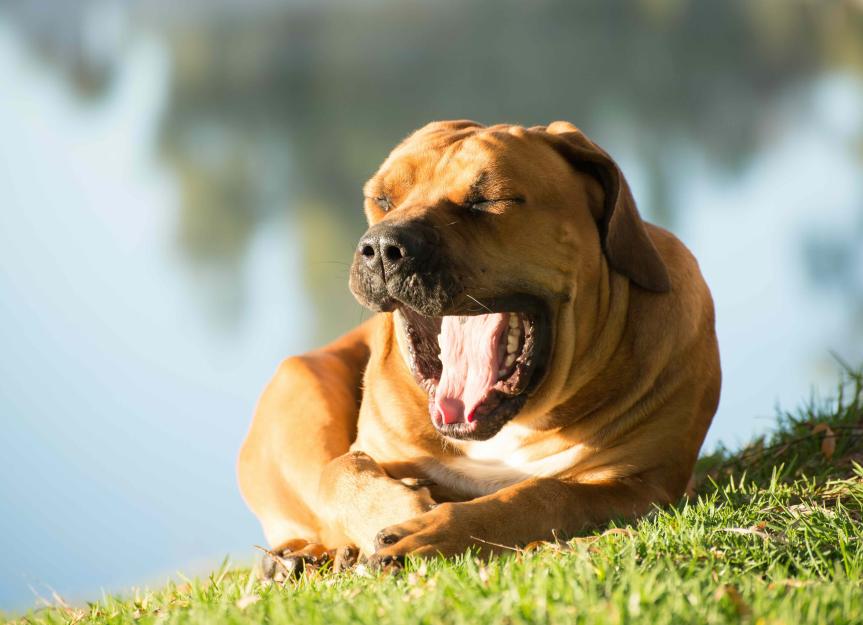
Sunshine helps with vitamin D, and being outside provides important physical and mental stimulation for your dog. But during the hot summer months, in climates with abundant sunshine, or even during a leisurely hike, protecting your dog’s health should be top of mind.
While providing flea and tick prevention and protecting your dog’s paws are typically top of mind, sun protection is equally important. But can dogs get sunburned like humans do?
Key Takeaways
- All dogs can get a sunburn, but it’s especially common in dogs with thin or light-colored fur.
- Dogs often develop sunburns on their nose, ear flaps, groin, belly, and around their eyes.
- Common signs of a dog sunburn include red, dry, and cracked skin.
- Take your dog to the vet if their sunburn is accompanied by other symptoms such as lethargy, vomiting, or a fever.
- Using dog sunscreen is the best way to prevent sunburns in dogs.
Can Dogs Get Sunburned?
Yes—if your four-legged family member spends time outside exposed to the sun, they can certainly get sunburned.
While all dogs are susceptible to sunburn, it’s more common in:
-
Dogs with immune-mediated skin diseases, such as lupus, which cause decreased pigment
Conversely, dogs with thick fur and those that are darker in color have a built-in barrier of protection against the sunlight and its harmful UV rays.
But even these dogs can have areas where their fur is thinner, leaving skin vulnerable to the sun. For example, dogs can get sunburned on their nose, ear flaps, belly, groin, hindquarters, and around the eyes due to their thin fur.
Dog breeds prone to sunburn include:
The environment also plays a role. Places with little to no shade and those that may have a reflective element, such as a large body of water, increase the likelihood that your dog can get sunburned.
Do Dogs Need Sunscreen?
Yes, dogs susceptible to sunburn (or pet parents who want to be proactive!) should wear sunscreen. But before you start slathering it on, here are a few tips:
-
Only use sunscreen specifically formulated for dogs, such as Lucky Pup Sunscreen. Pet parents should avoid putting sunscreen made for humans on their dog (unless your vet approves its use).
-
Read the label carefully. All sunscreens differ in terms of how long they need to be applied before sun exposure and how often they need to be reapplied. If your dog enjoys swimming and will be spending time in the water, you need to reapply sunscreen carefully.
How Can I Tell If My Dog Is Sunburned?
A dog’s sunburn can resemble many other skin conditions. Here are some of the most identifiable signs of a sunburn
Signs of sunburn that require an emergency vet visit include:
Dog sunburns often develop around the bridge of their nose, ear flaps, and around the eyes and mouth.
If your pup likes to lie on their back and sunbathe, their belly and groin are susceptible to sunburn as well. Sunlight can also reflect from surfaces and can cause your dog’s belly to become sunburned, especially if you have a low-to-the-ground breed, such as a Corgi or a Dachshund.
How to Prevent Dog Sunburns
It’s important to prevent dog sunburns. Sunburns not only cause pain, but they can also lead to open wounds, infection, and potentially serious systemic illness.
Like with humans, exposure to sunlight and ultraviolet (UV) rays can increase your dog’s likelihood of developing skin cancer, such as squamous cell carcinoma and hemangiosarcoma.
Sunburns can also exacerbate other underlying illnesses, such as autoimmune disease or kidney disease, which are often worsened by dehydration and infections.
Here’s how you can protect your dog from sunburns.
1. Use Dog Sunscreen
Sunscreen is the best measure to protect your pet from the harmful effects the sun can have on their skin.
Always apply sunscreen to your dog’s nose (especially if your pup’s nose is a light color, like pink), ear flaps (where the skin is fragile), and on their belly, groin, top of the head, neck, and back. Proper sunscreen application is essential for at-risk dogs, but any pup can benefit from it during outdoor summer activities.
2. Stick to Shady Areas
Providing your dog with plenty of shade and ways to escape the sun when needed can help decrease the chance of sunburn.
It’s best to avoid prolonged sun exposure altogether during peak times of UV (when the sun is at its strongest). Peak time is typically between 10 a.m. and 4 p.m., so schedule your summer walks before and after midday.
Keeping walks outside of peak times helps prevent sunburns and other heat-related illnesses like heatstroke.
3. Create a Physical Barrier
Pavement and water can reflect the sunlight and lead to sunburns. Consider placing a rug, artificial grass, or using a tent, a cooling doghouse, an elevated dog bed, or a covered dog bed to help protect your dog.
Your dog can also wear a hat or T-shirt to protect themselves from sun exposure by putting a physical barrier in the way of the harmful rays.
Dog Sunburn Treatment
If your dog gets a sunburn, always consult a veterinarian before giving any medication to them. It’s also best to schedule a vet appointment if you notice a sunburn to determine its severity and to receive an appropriate treatment plan for your dog right away.
Vets often prescribe pain medications, antibiotics, and appropriate topical therapy for dog sunburns.
While preparing to take your sunburned dog to the vet, applying a cool towel to the skin can help if there are no blisters or wounds.
Because most aloe products for dogs have other ingredients that can lead to aloe vera poisoning, it’s best to avoid these products unless approved by your veterinarian.



